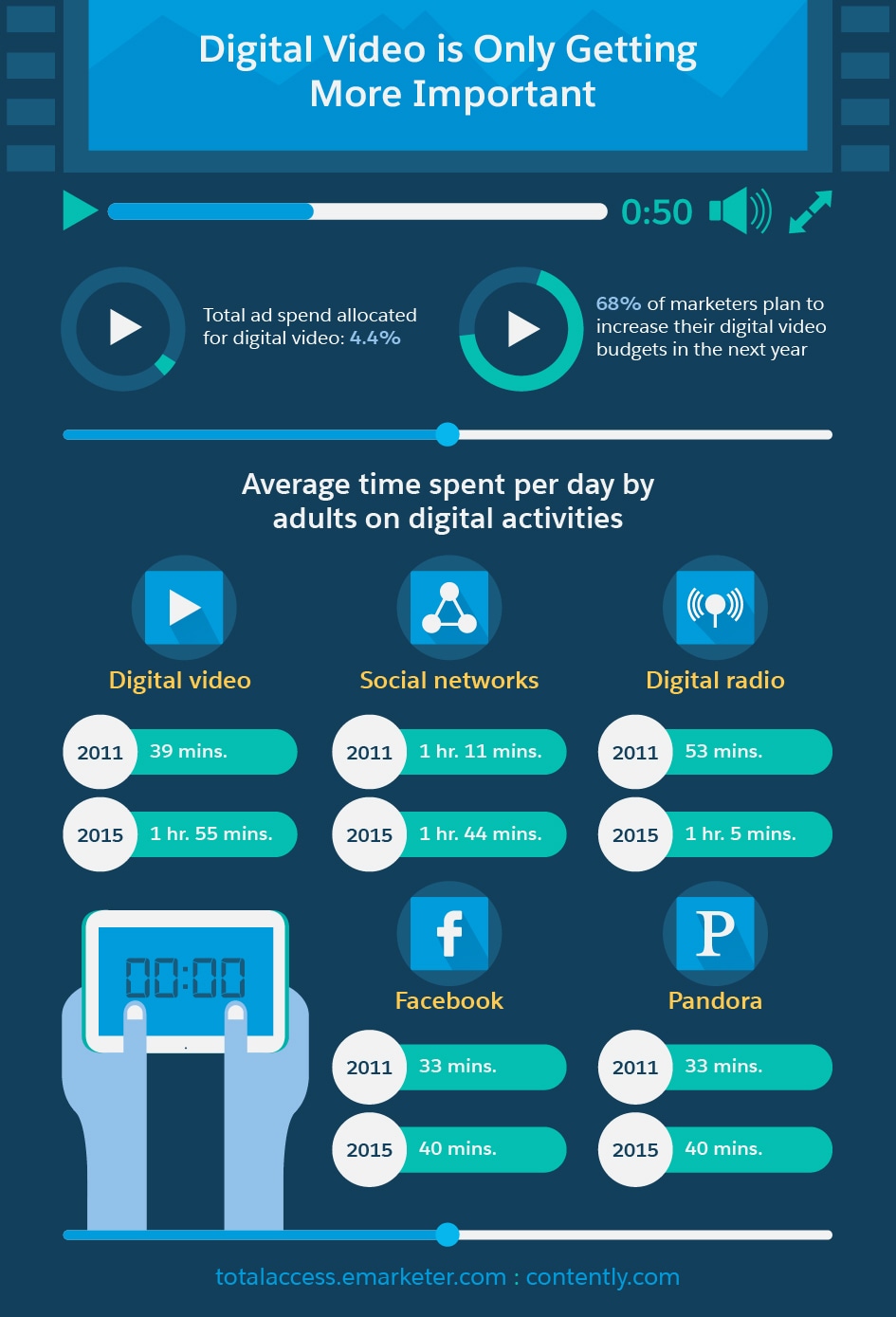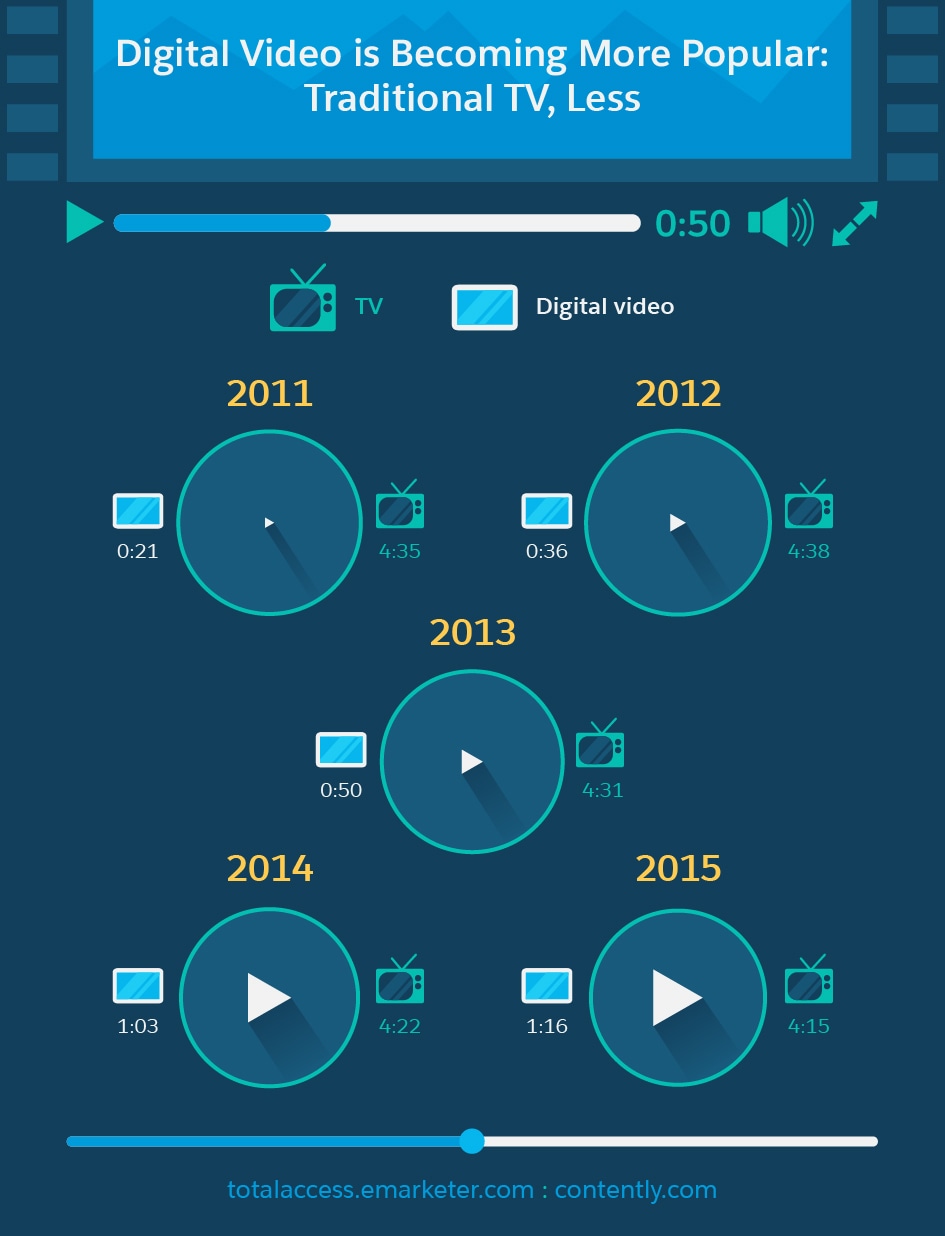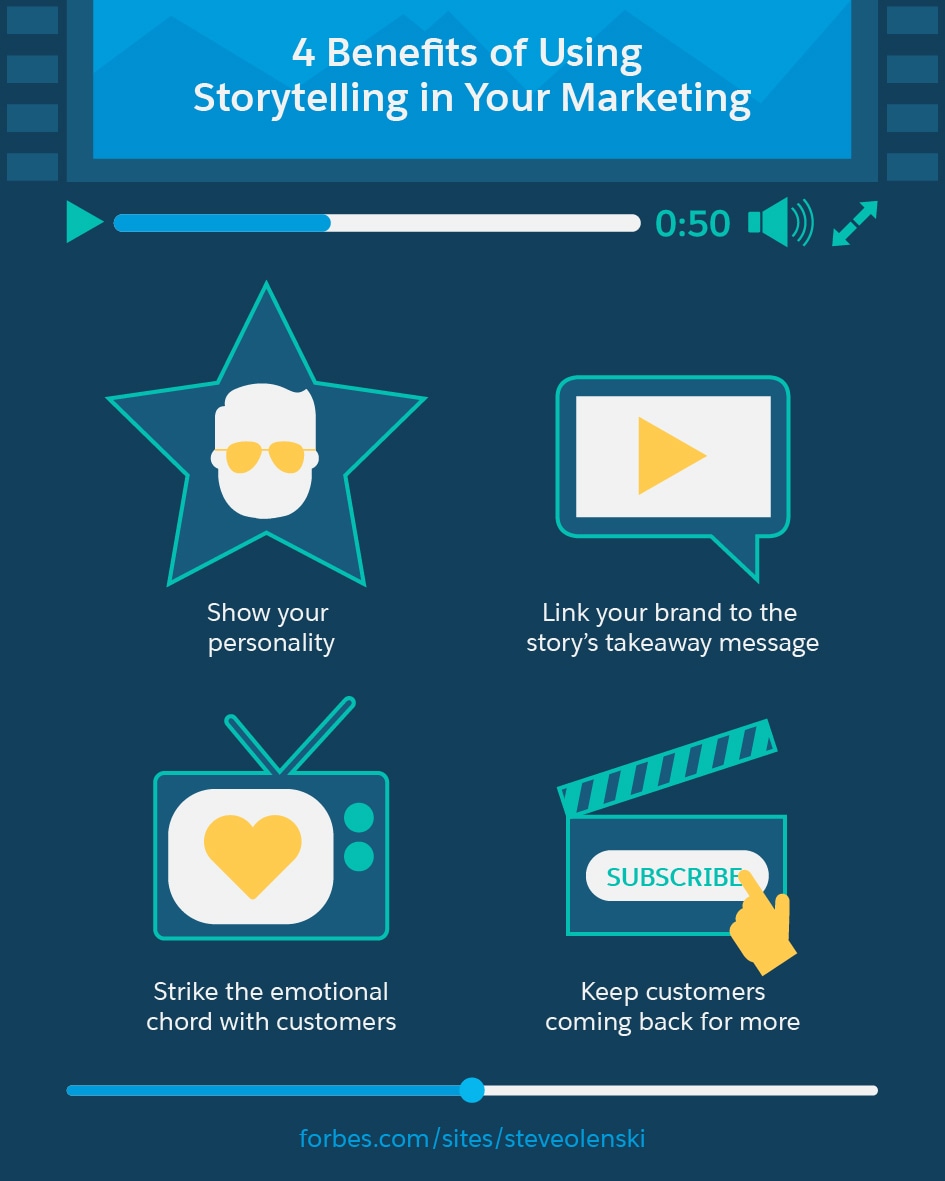Think for a moment about what it must have been like to be an advertiser in the dawn of the television era. You spent decades attempting to create dynamism through static photographs and drawings in print ads. You used the radio to encourage the audience to visualize products on their own. Then, all of a sudden, with television, you’re able to harness the power of video and share compelling visual stories directly with the consumer. It must have felt like an entirely new world of possibilities had opened up.
While this time may not prove to be quite as historically momentous as the introduction of television advertising, we are in a somewhat similar period of upheaval for B2B digital marketers, and it’s also connected to the use of video. The opportunities for creative uses of video marketing have exploded in recent years, and marketers are just beginning to reap the benefits of sending innovative video content directly to a user’s mobile device.
For nearly a decade, YouTube was the dominant player in video streaming. Today, Facebook Video, Snapchat, and Instagram Stories are giving YouTube a run for its money. Is your business taking advantage of the billions of video views these platforms serve each day?
Facebook’s massive reach is now common knowledge, even outside the tech world: Its user base had climbed above 1.5 billion by the fourth quarter of 2015. The social giant’s introduction of Facebook Live Video is a significant development for B2B marketers, as this has created new possibilities for engaging with a potentially massive audience.
What’s less well known outside the technoverse is how Snapchat has disrupted the social media marketing world, and how new brands are discovering its potential everyday. The latest estimates show that Snapchat has surpassed 150 million daily users. Snapchat’s users tend to be among the most dedicated and engaged of any social media platform, and savvy marketers are learning how they can leverage this engagement by creatively using the Snapchat Stories feature.
Which Social Platform Is Right for You?
Facebook is right for you if:
- You are building a community presence or want to reach as broad a network as possible
- While it’s the most popular platform with a high level of engagement, many users primarily use it to connect with friends and family
- More than 70% of online adults actively use Facebook
Twitter is right for you if:
- You want to post topic-based news or timely insights
- Best if you want to reach both men and women, especially younger ones
- 18% of online adults actively use Twitter
LinkedIn is right for you if:
- You are in B2B or another industry or role where you can provide useful insights about business, seeking business connections, etc.
- Optimal for peer networking and industry-specific information
- 22% of online adults actively use LinkedIn
Instagram is right for you if:
- You have a visual aspect to your business
- Engagement on Instagram is 15 times that of Facebook
- 17% of online adults actively use Instagram

Probably the most compelling reason for B2B marketers to use new-generation video marketing techniques is that they are inexpensive and low-risk with the potential for high rewards. Unlike YouTube videos, which tend to look better the more produced they are, Facebook Live Video, Snapchat Stories, and Instagram Stories can be compelling with very little investment in production values and editing. In the new world of video marketing, you can make an impression on the social scene and connect with your audience in new ways by developing a consistent strategy that guides and informs your initiatives.
Understand the differences between each platform
The first thing to take into account is that not all social media outlets that feature video marketing tools are created equal. You wouldn’t try to shoehorn a detailed product description into a banner ad anymore than you should try to recreate a highly edited commercial on Facebook Live Video. Each platform features unique attributes that need to be considered when creating content for that outlet, lest your message get muddled and lost.
Facebook Live Video, for instance, is great for when you want to create a sense of immediacy surrounding an event. Perhaps you are putting on an interactive product demonstration for a brand new offering, and this is the public’s first glimpse of it. Or you could solicit questions from your followers and do a live Q&A session. Your enthusiastic users can share the video feed with their followers, adding to the sense that everyone is sharing in a unique and finite experience.
Snapchat Stories, meanwhile, give you the opportunity to enhance otherwise mundane content with creative filters and add-ons. Also, because Snapchat users must specifically seek out the accounts they follow, either by typing in the exact username or taking a photo of a unique Snapcode, your followers tend to be highly engaged with your brand. You can use this information to skip over entry-level content that would provide value for an uninitiated audience member and focus on content for your most fervent supporters.
Know what you want to gain from your video marketing program
In the rush to take advantage of the next phase of digital video marketing, you may be tempted to jump on the bandwagon and produce content and set goals later. If you fall into this trap, you’ll begin your video marketing effort without benchmarks that you can use to measure results against and make changes to your program going forward.
Video marketing may be the wave of the future, but that doesn’t mean you can abandon sound marketing processes in search of something shiny and new.
Whatever you hope to accomplish with video marketing, it should be defined at the outset of the process and be used to tailor your strategy. If you want to grow website traffic, include a unique URL in your videos to push your audience toward the site. Alternatively, if your brand needs to make inroads with Millennials, you can dive deeply into Snapchat, which reaches over 40 per cent of the 18 to 34 demographic every day.
Compare Competitors’ Posts with Rival IQ
- Rival IQ allows users to analyze competitors’ top content on each social network
- The analysis can help determine:
- Whether you should post photos or videos
- When you should post them
- The type of captions you should include for best engagement opportunities
- By looking at competitors’ successful posts, you can come up with unique ideas that fit with the social network you choose to focus on

Develop a brand identity for your video marketing that fits into your overall brand
You can think of your video content as a brand within a brand, and it should maintain consistency of tone, design, and authenticity—just like with the overall organization’s brand management. This doesn’t mean that everything has to be the same, of course, but all the content you produce should serve to reinforce a specific brand identity for the audience.
Once you outline the specific attributes of your video marketing brand, make sure they are completely compatible with your overall brand strategy. If your followers sense a disconnect between your brand identity and the video content that you post, you run the risk of seeming inauthentic.
Demonstrate value to your audience early and often
Among the many excellent attributes of social media video marketing, one thing to bear in mind is that audiences are selective about the content they consume. Therefore, it is important to share videos that offer viewers immediate educational or entertainment value. Consumers are surrounded by competing visual stories. Give your audience a compelling reason to watch your content clearly and early in the piece, and hook them into viewing for the entirety by teasing valuable information that will be revealed throughout and at the end.
Take the audience places they normally wouldn’t have access to
One of the great powers of video marketing is the ability to take the audience somewhere they weren’t expecting, such as giving them a behind-the-scenes look at an organization or a glimpse into the life of a well-known figure. This kind of content helps you forge a special connection with the user because they feel like they are gaining intimate access to something that not everyone gets to experience. What’s great about this is that it allows you to engage with your diehard fans by rewarding them for their loyalty with special access. It also provides you with an opportunity to tease content that will draw in a new audience.
Embrace the storytelling aspect
Sound marketing and sales strategies are always centered around an aspect of storytelling, and video marketing creates unique possibilities for enhancing your storytelling experience. Use Facebook, Snapchat, and the like to take your audience on a journey along with your brand, and show them how they fit into the narrative.
One way to accomplish this is to make your stories interactive so that social media users can directly contribute to the creative process and deepen their bond with your brand. When it’s used effectively, video marketing allows you to transition from, “Here is a story we are telling you,” to, “Here is a shared narrative that we can create together.”
9 Things to Learn From Your Competitor’s Social Media Strategy
1. The networks they use
What to do:
- Search your competitors by name. On the first two pages of search results, you will find the top social networks where your competitors have profiles.
- Compare yourself and your competitors on Rival IQ to see which networks your competitors have a following.
- Or create a spreadsheet to log competitor's fan and follower counts.
2. How competitors position themselves
What to do:
Use competitor research tools or visit each of your competitor's profiles for bio inspiration.
3. Types of visuals competitors use
What to do:
- Visit each of your competitor's profiles to see what they use for cover and profile photos on specific networks.
- Do they use photos? What about graphics?
4. How often competitors post
What to do:
- Use a competitor research tool to tally the number of updates your competitors post.
- Take a peek at the engagement your competitors receive on each social network.
- Analyze the number of posts and engagement to see where competitors receive the most (or least) audience response.

Cross-promotion is great, but provide unique content for each platform
It’s wise to use your other social media accounts to promote video content that appears on a competing platform. Since users on Snapchat need your exact username or Snapcode in order to follow you, you should take every opportunity to share your Snapcode on other outlets and websites in order to generate awareness.
This doesn’t mean, however, that you should create video content for one platform and share it directly to other channels. You’re not dealing with interchangeable media here, and this is a mistake many businesses make. Use your accounts to promote each other, but produce specific content for each platform.
Measure your progress in connection with your goals and improve your efforts
The most effective way to not lose sight of why you’ve instituted a video marketing initiative in the first place is to measure your success against your stated goals and tweak your program to keep improving. Thankfully, the platforms themselves have some tools for business users that you can use to get started on measuring the effectiveness of your video marketing program.
Facebook prides itself on its wealth of demographic and user data, and it offers an impressive, comprehensive set of tools for marketers to track their progress. They make it relatively simple to distill comments, likes, and shares into quantifiable levels of reach and audience engagement, and you can also break these statistics down by different demographic factors.
While Snapchat doesn’t have quite the robust set of tools that Facebook boasts as of yet, you can still track who has viewed a Snap or Story as well as which users have engaged via a response.
Set goals, produce great video content for your channels, and measure your success. Most brands should find that video marketing is an important tool for building brand awareness, loyalty, and popularity.
Share "How Businesses Can Take Advantage of the Power of Video Marketing" On Your Site



